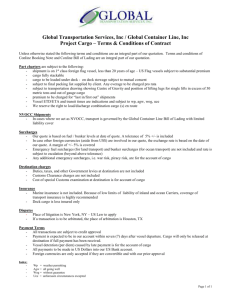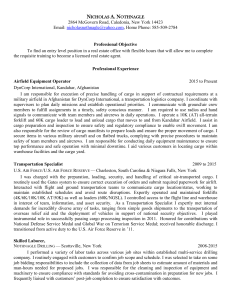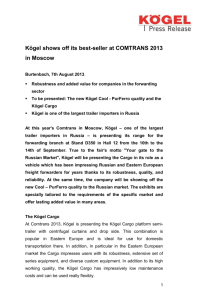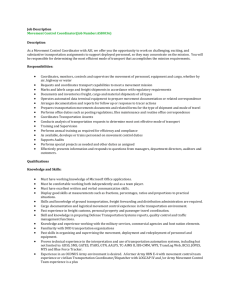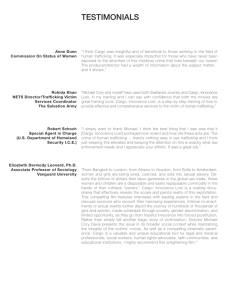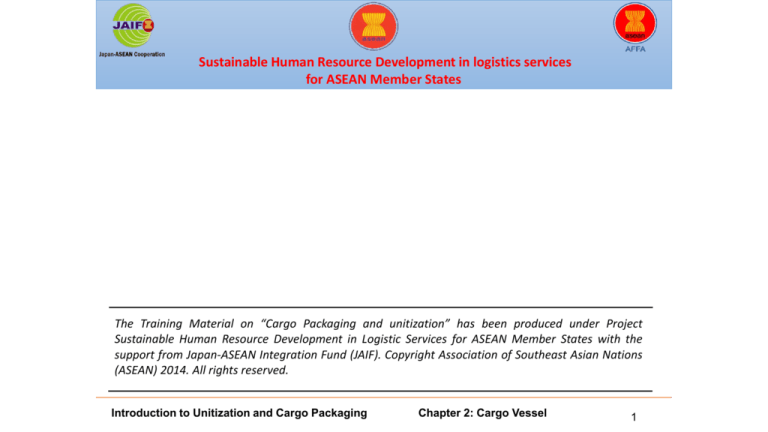
Sustainable Human Resource Development in logistics services
for ASEAN Member States
The Training Material on “Cargo Packaging and unitization” has been produced under Project
Sustainable Human Resource Development in Logistic Services for ASEAN Member States with the
support from Japan-ASEAN Integration Fund (JAIF). Copyright Association of Southeast Asian Nations
(ASEAN) 2014. All rights reserved.
Introduction to Unitization and Cargo Packaging
Chapter 2: Cargo Vessel
1
Sustainable Human Resource Development in logistics services
for ASEAN Member States
Chapter 2 – Cargo Vessel
Objectives & Introduction
2.1 LASH – Lighter Abroad Ship
2.2 RORO – Roll On / Roll Off
2.3 Barges and container vessels
Introduction to Unitization and Cargo Packaging
Chapter 2: Cargo Vessel
2
Sustainable Human Resource Development in logistics services
for ASEAN Member States
Objectives
Students are to understand the availability of different types and functions of vessels available.
Introduction to Unitization and Cargo Packaging
Chapter 2: Bulk Cargo Vessel
3
Introduction
Sustainable Human Resource Development in logistics services
for ASEAN Member States
Bulk Cargo Vessel or Bulk Carrier are ships specially designed to transport unpackaged bulk cargo, such as
grains, coal, ore, and cement in its cargo holds. Since the first specialized bulk carrier was built in 1852, economic
forces have fuelled the development of these ships, causing them to grow in size and sophistication. Today's
bulkers are specially designed to maximize capacity, safety, efficiency, and to be able to withstand the rigours of
their work. A bulk carrier's crew participates in the loading and unloading of cargo, navigating the ship, and
keeping its machinery and equipment properly maintained. Loading and unloading the cargo is difficult,
dangerous, and can take up to 120 hours on larger ships. Crews can range in size from three people on the
smallest ships to over 30 on the largest. Bulk cargo can be very dense, corrosive, or abrasive. This can present
safety problems: cargo movements, spontaneous combustion, and cargo saturation can threaten a ship. The use
of ships that are old and have corrosion problems has been linked to a spate of bulker sinking in the 1990s, as
have the bulker's large hatchways, important for efficient cargo handling. New international regulations have since
been introduced to improve ship design and inspection, and to streamline the process of abandoning ship.
Introduction to Unitization and Cargo Packaging
Chapter 2: Cargo Vessel
4
Sustainable Human Resource Development in logistics services
for ASEAN Member States
2.1 LASH – Lighter Abroad Ship
The lighter aboard ship (LASH) system refers to the practice of loading barges or lighters aboard a larger
vessel for transportation. It was developed in response to a need to transport lighters, a type of unpowered
barge, between inland waterways separated by open seas. Lighters are typically towed or pushed around
harbours, canals or rivers and cannot be relocated under their own power. The carrier ships are known
variously as LASH carriers, barge carriers, kangaroo ships or lighter transport ships. The LASH system was
developed as an alternative and supplement to the developing container system. The lighters, which may be
characterized as floating cargo containers, served dual purposes: transportation over water, and the
establishment of a modular, standardized shape for loading and unloading cargo. The lighters, also known
as swimming normed cargo containers, are loaded onto a LASH carrier at the port of embarkation and
unloaded from the ship at the port of destination.
Introduction to Unitization and Cargo Packaging
Chapter 2: Cargo Vessel
5
Sustainable Human Resource Development in logistics services
for ASEAN Member States
SS Cape Farewell - Lighter Aboard Ship
SS Cape Fear -- Lighter Aboard Ship - showing lifting of "lighter"
Introduction to Unitization and Cargo Packaging
Chapter 2: Cargo Vessel
6
Sustainable Human Resource Development in logistics services
for ASEAN Member States
2.2 RORO – Roll On Roll Off
Roll-on/roll-off or more commonly called RORO ships are vessels designed to carry wheeled cargo, such as
automobiles, trucks, semi-trailer trucks, and railroad cars, that are driven on and off the ship on their own wheels. This
is in contrast to Lift-on/Lift-off (LoLo) vessels, which use a crane to load and unload cargo.
RORO vessels have built-in ramps that allow the cargo to be efficiently rolled on and off the vessel when in port. While
smaller ferries that operate across rivers and other short distances often have built-in ramps, the term RORO is
generally reserved for larger oceangoing vessels. The ramps and doors may be stern-only, or bow and stern for quick
loading. Types of RORO vessels include ferries, cruise ferries, cargo ships and barges. New automobiles that are
transported by ship are often moved on a large type of RORO called a pure car carrier (PCC) or pure car/truck carrier
(PCTC). In the shipping industry, cargo is normally measured by the metric tonne, but RORO cargo is typically
measured in lanes in metres (LIMs). This is calculated by multiplying the cargo length in metres by the number of decks
and by its width in lanes (lane width differs from vessel to vessel, and there are several industry standards).
Introduction to Unitization and Cargo Packaging
Chapter 2: Cargo Vessel
7
Sustainable Human Resource Development in logistics services
for ASEAN Member States
RORO Vessel
Introduction to Unitization and Cargo Packaging
Chapter 2: Cargo Vessel
8
Sustainable Human Resource Development in logistics services
for ASEAN Member States
2.3 Barges and container vessels
A barge is a flat-bottomed boat, built mainly for river and canal to transport heavy goods. Some barges are not
self-propelled and need to be towed or pushed by towboats. Container ships are cargo ships that carry all of
their load in truck-size intermodal containers, in a technique called containerization. They are a common
means of commercial intermodal or multimodal freight transport and now carry most seagoing non-bulk cargo.
Container ship capacity is measured in twenty-foot equivalent units (TEU).
Typical loads are a mix of 20-foot and 40-foot (2-TEU) ISO-standard containers, with the latter predominant.
Container vessels eliminate the individual hatches, holds and dividers of the traditional general cargo vessels.
The hull of a typical container ship is a huge warehouse divided into cells by vertical guide rails. These cells
are designed to hold cargo in pre-packed units – containers.
Shipping containers are usually made of steel, but other materials like aluminium, fiberglass or plywood are
also used. They are designed to be entirely transferred to and from trains, trucks or trailers. There are several
types of containers and they are categorized according to their size and functions.
Introduction to Unitization and Cargo Packaging
9
Sustainable Human Resource Development in logistics services
for ASEAN Member States
Introduction to Unitization and Cargo Packaging
Chapter 2: Cargo Vessel
10

